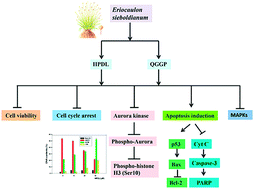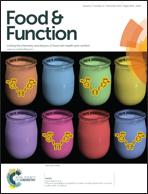Bioactive compounds of Eriocaulon sieboldianum blocking proliferation and inducing apoptosis of HepG2 cells might be involved in Aurora kinase inhibition†
Abstract
Eriocaulon sieboldianum (Sieb. & Zucc. ex Steud.) is an edible and medicinal plant used in traditional Chinese medicine. Often in combination with other herbs, it is processed into healthcare beverages for expelling wind-heat, protecting eyes, and reducing blood lipids. Besides, its water decoction together with other herbs has been utilized to treat cancer in China. However, the active ingredients and the precise cellular mechanisms of E. sieboldianum remain to be elucidated. The Aurora kinase family plays critical roles in the regulation of cell division and has attracted great attention to the identification of small-molecule Aurora kinase inhibitors for potential treatment of cancer. A molecular docking study was employed for docking of the most bioactive compounds. Hispidulin (HPDL) and quercetin-3-O-(6′′-O-galloyl)-β-D-galactopyranoside (QGGP) were singled out as potent inhibitors of Aurora kinase. Their inhibitory activity towards Aurora kinase was further confirmed by the obvious decrease in autophosphorylation of Aurora-A (Thr288) and Aurora-B (Thr232). Moreover, the induction of cell cycle arrest in HepG2 cells and the suppressed phosphorylation of histone H3 were also consistent with the inhibition of Aurora kinase. The data indicate that the E. sieboldianum extract and its two active compounds, HPDL and QGGP, could effectively induce apoptosis via p53, MAPKs and the mitochondrial apoptotic pathways. These findings could improve the understanding and enhance the development of drugs based on E. sieboldianum and raise its application value in anticancer therapy or prevention. In addition, our results indicated that Aurora kinase might be a novel target of HPDL and QGGP.


 Please wait while we load your content...
Please wait while we load your content...